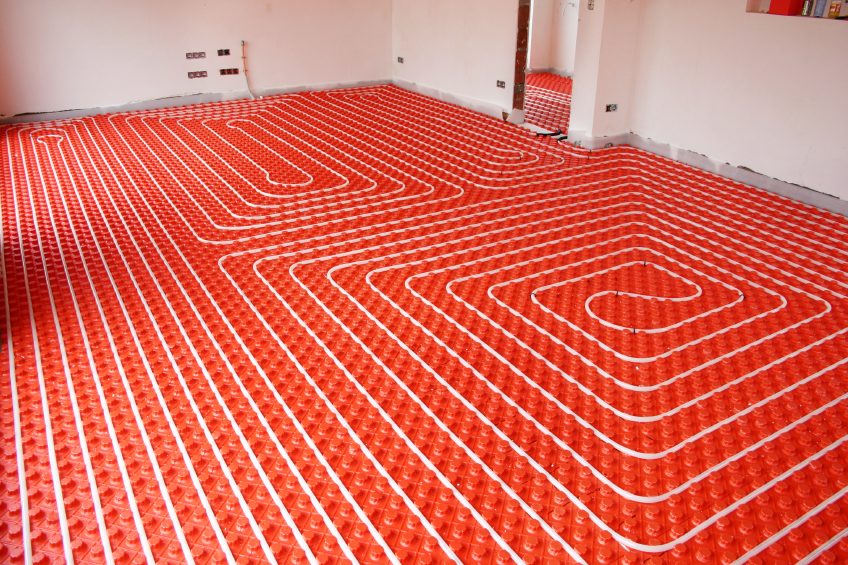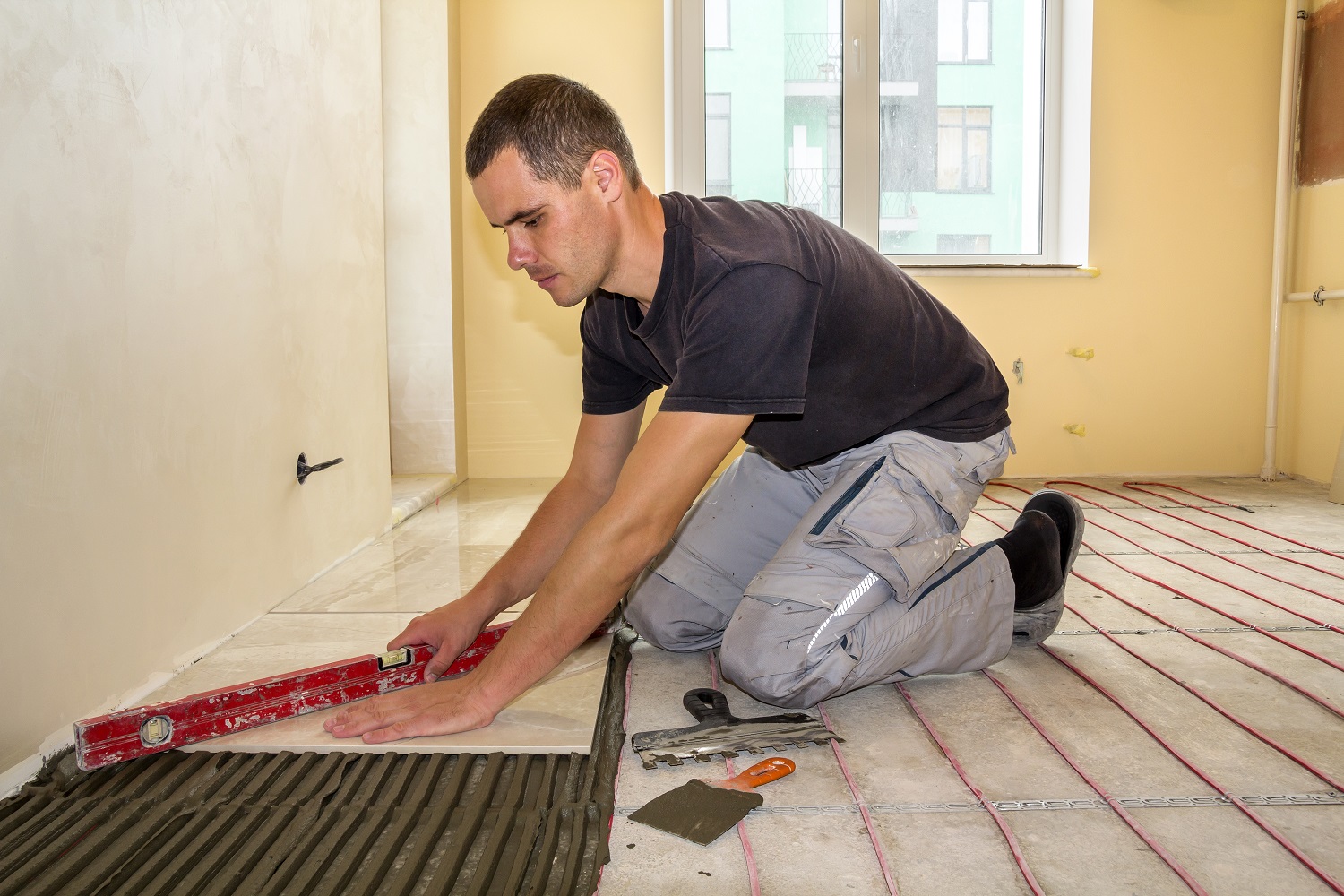Heated floors: Types, installation, Pros/cons, and FAQs
Floor heating, or radiant floor heating, is one luxurious trend that has been popular since the Roman Empire to keep your toes toasty warm. It is basically a form of central heating achieved by embedding heating elements in a floor.
It ensures that you live a cozy, clean, relaxing life because most homes tend to have “cold spots,” whether on tile flooring or cemented slabs.
Electric floor heating is most commonly used nowadays, creating warmth below the flooring and radiating it upward to make your room cozier. The significant difference between traditional and radiant heating systems is that the latter directly warms people and objects. Typically, the maximum floor temperature is noted to be 104° F.
Do you know what its warmth feels like? Just like the sun.
Types of heated floors
ELECTRIC RADIANT FLOORS
This system uses heating elements that look like they are woven into the floor and are powered by electricity, just like an electric blanket. Such an in-floor heating system offers easy installation and many other perks, such as quick heating (30–60 minutes maximum) and cut overall cost.
On installation, the floor height will get slightly raised. The usual range of the circuit to work is 15 to 20 amps. It is an ideal choice for providing a source of supplemental heat. It would help if you lay the strips of electrical matting during remodeling.
This system is also best suited for heated driveways.

AIR HEATED RADIANT FLOORS
Also called a forced-air heating system, it uses hot air to heat the floor without causing any trouble. After all, the air is easier to push because of its lighter weight. Hot air flows through the tubes, heating the floor quickly, and radiating into the surroundings.
Suitable for all buildings and floors, you can install ducts and pipes for air to flow under the hardwood, ceramic, tile, stone, vinyl, laminate, or linoleum floors.
HYDRONIC RADIANT FLOORS
As the name implies, this efficient system makes the best use of hot water by letting it circulate in a loop through the tubes to heat the floor surface. It is designed in a completely closed layout.
Best suited for large floors, it can heat the entire house. Instead of remodeling, this system should be installed during the construction phase. Hydronic floor-heating systems also raise your floor height.
The major drawback is that it is a slow process and takes a greater amount of time to heat the floor. It would be best to leave it on for hours to get a suitable temperature, making it less energy efficient.
Heated floors cost
- For air-heated systems, the cost is approximately $14 per square foot which does not enlist the expenses of the flooring reinstallation over the laid-out ducts.
- For electric floor-heating systems, the range is $10 to $20 a square foot. The operational cost can get raised in case of living at a place where electricity charges are high.
- Out of three, hydronic floor-heating systems are comparatively expensive as so much equipment needs to be fitted, such as a boiler, a pump, and gas lines.
- The cost of heating a house can be reduced if you know when to turn on the heat.
Pros and cons of heated floors
Pros
- Every system is designed to heat the floor uniformly, ensuring that you get an evenly heated room. No more cold, ONLY comfortable and cozy feelings!
- All Underfloor heating systems are whispered quiet. They work noiselessly and smoothly without disturbing your peaceful night’s sleep.
- As floor-heating systems can heat objects and warm people directly without blowing the winds, they do not increase or decrease any existing allergens present in the surrounding.
- All systems are highly energy-saving, primarily electric floor-heating systems. They tend to be 25% more energy-efficient compared to the forced-air systems as they experience no leakage.
Cons
- Complete flooring needs to be replaced to install floor-heating systems; the existing flooring must be removed.
- A slight yet pretty visible increase in the floor height will result from installing heating elements under surface flooring.
- The installation cost can get high, making it not a cost-effective option.
- Apart from price, installing a heated system can get complicated, requiring a team of skilled electricians and other professionals.
- The time required for installation is longer than a traditional heating system, which can be a significant problem.

Heated floors installation
Depending on the type of heating system you have chosen, the installation process can be different. Here are 8 radiant floor systems. That is why you must read the instructions. Apart from having subtle differences, two main types of installation are:
Wet installations – Entire floor heating system is laid out in a concrete layer during the construction phase.
Dry installations – A newer approach where the heating system is layered below, above, or between the subfloors. It doesn’t require another layer of concrete; it is an ideal choice when retrofitting an entire system into an existing home.
Did you know that you can install heated seats in your car too?

DIY heated floors
Genuinely speaking, installing a floor-heating system is a pretty easy task. Any DIYer can do it by following the instructions. In comparison to hydronic systems, the electric system is easier to set up.
You might need assistance from a professional for water or air-forced heating system installation. Some of the easy steps for DIY heated floors you must consider are:
- Start with cleaning your subfloor.
- Place your heated system following the installation guidelines.
- Remove the tiles and find the center of the floor.
- Mark lines and starts laying the tiles again
- Once laid out, set the tiles and cut the excessive parts.
- Time to clean the mess by removing an extra thin set. Make sure that the tile surface and joints are all cleaned up.
- Complete your grout segment by following up with grout haze remover to clean the surface of the tile.
FAQs
Can you put heated floors under hardwood?
Yes, you can. As far as the best option is concerned, always choose an “electric underfloor heating system.” It tends to work well because wood can conduct and hold the warmth produced by the embedded heating elements and then radiate it upward around the room evenly.
Moreover, wood heats up fast and traps the heat (retains the warmth), not letting it escape. For effective performance, try keeping the thickness and density of hardwood flooring no more than 18mm.
Can you put a heated floor under the vinyl?
Absolutely, yes! You can install a heated system under the vinyl floor safely. You would experience no vinyl discoloration or shrinkage. Be careful about the vinyl floor temperature, as it should never cross 27°C. The best way is to choose “wet installation.” Vinyl works well with electric underfloor heating.
Do heated floors use a lot of electricity?
It is a myth as electric underfloor heating tends to be highly energy-saving compared to other traditional central heating systems. So, the answer is NO. A heated floor doesn’t use a lot of electricity. In fact, they are made energy-efficient, letting you save money on gas and electricity.
The cost for the electric system is less than 10p a square meter if it has been running at full power for a continuous 6 hrs. To manage the heat and make it a more affordable option, get yourself a programmable thermostat. Most systems use 12 watts/hour/square foot, or 300 watts that is significantly LESS than the average space heater.
Can you have heated wood floors?
Whenever you opt for underfloor heating, we don’t prefer floors made with solid wood because wood has never been a good conductor of heat. A wood floor will take more time to heat up, and letting the heat escape means it will not retain the heat. Keep the underfloor heating temperature limited to 27 degrees C.
If you really want to have a wooden heated floor, keep the wood thinner and denser, so the heat-up time gets fast and the system works more efficiently.
Can heated floors heat a house?
Yes, why not! Heating the entire house with an underfloor heating system is possible and is also safe.
As the heating elements, whether water, air, or electricity, go right into the floor layering, it (water, air, electricity) runs throughout the house, radiating heat. It is typically a room-specific device but is a feasible way to heat the entire home. Prefer choosing the hot water method (hydronic).
Can heated floors heat a room?
The short answer is yes. All heating systems are efficient enough to heat the room evenly with a uniform heat distribution creating a cozy warm environment. Radiant heat offers warmth emerging from the floor up through the apartment without leaving any cold spots.
The most practical pick is electric radiant floor heating, as hydronic systems will require an extensive setup and complicated upkeep.
Don’t forget to look for the factors that can make the heat escape, such as outside walls, non-weather-treated windows, non-insulated concrete subfloors, and unheated rooms beneath the floor.
Can heated floors cause fires?
No, heated floors cannot cause fire or suddenly burst into flames. They are safe to use, easy to maintain, and practical options for heating floors, rooms, and even the entire home. Carefully installed underfloor radiant heat systems can never be a safety hazard.
They are safe and reliable, but you must read the precautions and guidelines provided by the company to avoid any accidents.
Can heated floors go under the carpet?
You can lay out your heating system under the carpet. The most suitable and practically feasible system is “electric heating.” For under-carpet floor heating, proper care is required. The underlay must have little thermal resistance, whereas the carpet must be hessian-backed to support efficient performance. Try to keep the floor temperature below 80°F/27°C. Don’t forget to insulate your subfloor to retain the heat better.
Can heated floors go under laminate?
Oh, yes, having Laminate flooring layering your radiant heated floor can never go wrong. In fact, it is the perfect pick. Just make sure that the material is not excessively thick. The maximum thickness can be no more than 18mm, or else it will hinder the heating performance. Typically, the laminate floorings are made to handle the maximum temperature of 85 degrees F. Go for installing an electric radiant heating system.
Can heated floors be turned off?
The heated floors can be turned off whenever needed. If you have installed a programmable thermostat, you might not need to turn it on or off the system manually. In hydronic and air systems, you can directly turn off the valve. For more details, you need to read the instructions delivered by the company as there will be subtle changes in procedures.
Can heated floors get wet?
Yes, they can, but you need to put underfloor mats that must be water-proof to avoid the situation.
Are heated floors worth the cost?
Why not? Heated floors keep you warm, cozy, and comfortable in the cold season. They are made energy- and cost-efficient, as well. Moreover, heated floors use heating elements that are safe to use and easy to maintain. It seems workable for people with allergies, too. Most options are made eco-friendly.
While heated floors are best for indoors, don’t forget to wear heated gloves, battery heated Socks, and a rechargeable hot jacket when you go outdoors. When you come back, heated driveway system will melt all the snow, so you won’t have any issues.
Additional Questions
What type of flooring is best for heated floors?
The optimum choice for flooring that can work with heated floors is Porcelain or Ceramic Tile. These types of tiles are extremely thin which makes them a perfect choice since they allow for the easy transfer of heat. Additionally, due to their mineral-based nature, they are excellent conductors of heat. From my personal experience, houses with Porcelain or Ceramic Tile flooring have always given the best radiant heating effect, creating a warm and cozy ambience during the cold months.
What are the different types of underfloor heating installation?
When it comes to underfloor heating installation, you basically have two options. You can go for either electric underfloor heating or warm water underfloor heating systems. They both work in pretty much the same way in heating up the floor. In fact, over my years of experience in the industry, I’ve found that the choice between these two often boils down to personal preferences and specific installation requirements, as both systems have proven to be highly effective.
What are the disadvantages of heated floors?
Although heated floors come with a plethora of benefits, it’s essential to consider the downsides before making a decision. Some potential drawbacks might include the costs and the time involved in the installation process, particularly for hydronic systems. Furthermore, you might need to consider the impact on floor height, as the installation of underfloor heating can lead to a slight height increase. These are aspects I’ve seen people overlook in my career, only to regret it when they have to deal with them after installation.
What are the pros and cons of heated floors?
Heated floors are a luxurious addition to any home and offer unparalleled comfort during cold seasons. However, as with anything, they come with their own set of pros and cons. On the plus side, they provide consistent and efficient heat, eliminate the need for bulky radiators, and are generally easy to run. However, the upfront cost, potential for increased floor height, and the time needed for full installation are factors that need to be considered. Personally, I believe understanding these trade-offs is key to making an informed decision about installing heated floors.

Annika Ramos is a physiotherapist with a passion for helping people recover from injuries and illnesses. In her spare time, she enjoys exploring her creative side through various craft projects.

